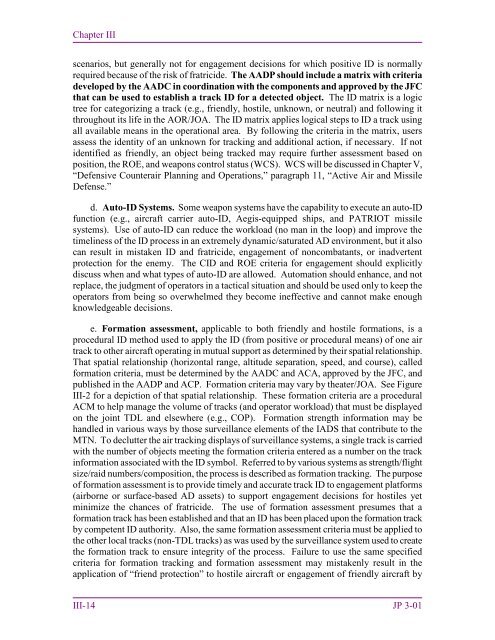JP 3-01 Countering Air and Missile Threats - Defense Innovation ...
JP 3-01 Countering Air and Missile Threats - Defense Innovation ...
JP 3-01 Countering Air and Missile Threats - Defense Innovation ...
Create successful ePaper yourself
Turn your PDF publications into a flip-book with our unique Google optimized e-Paper software.
Chapter III<br />
scenarios, but generally not for engagement decisions for which positive ID is normally<br />
required because of the risk of fratricide. The AADP should include a matrix with criteria<br />
developed by the AADC in coordination with the components <strong>and</strong> approved by the JFC<br />
that can be used to establish a track ID for a detected object. The ID matrix is a logic<br />
tree for categorizing a track (e.g., friendly, hostile, unknown, or neutral) <strong>and</strong> following it<br />
throughout its life in the AOR/JOA. The ID matrix applies logical steps to ID a track using<br />
all available means in the operational area. By following the criteria in the matrix, users<br />
assess the identity of an unknown for tracking <strong>and</strong> additional action, if necessary. If not<br />
identified as friendly, an object being tracked may require further assessment based on<br />
position, the ROE, <strong>and</strong> weapons control status (WCS). WCS will be discussed in Chapter V,<br />
“Defensive Counterair Planning <strong>and</strong> Operations,” paragraph 11, “Active <strong>Air</strong> <strong>and</strong> <strong>Missile</strong><br />
<strong>Defense</strong>.”<br />
d. Auto-ID Systems. Some weapon systems have the capability to execute an auto-ID<br />
function (e.g., aircraft carrier auto-ID, Aegis-equipped ships, <strong>and</strong> PATRIOT missile<br />
systems). Use of auto-ID can reduce the workload (no man in the loop) <strong>and</strong> improve the<br />
timeliness of the ID process in an extremely dynamic/saturated AD environment, but it also<br />
can result in mistaken ID <strong>and</strong> fratricide, engagement of noncombatants, or inadvertent<br />
protection for the enemy. The CID <strong>and</strong> ROE criteria for engagement should explicitly<br />
discuss when <strong>and</strong> what types of auto-ID are allowed. Automation should enhance, <strong>and</strong> not<br />
replace, the judgment of operators in a tactical situation <strong>and</strong> should be used only to keep the<br />
operators from being so overwhelmed they become ineffective <strong>and</strong> cannot make enough<br />
knowledgeable decisions.<br />
e. Formation assessment, applicable to both friendly <strong>and</strong> hostile formations, is a<br />
procedural ID method used to apply the ID (from positive or procedural means) of one air<br />
track to other aircraft operating in mutual support as determined by their spatial relationship.<br />
That spatial relationship (horizontal range, altitude separation, speed, <strong>and</strong> course), called<br />
formation criteria, must be determined by the AADC <strong>and</strong> ACA, approved by the JFC, <strong>and</strong><br />
published in the AADP <strong>and</strong> ACP. Formation criteria may vary by theater/JOA. See Figure<br />
III-2 for a depiction of that spatial relationship. These formation criteria are a procedural<br />
ACM to help manage the volume of tracks (<strong>and</strong> operator workload) that must be displayed<br />
on the joint TDL <strong>and</strong> elsewhere (e.g., COP). Formation strength information may be<br />
h<strong>and</strong>led in various ways by those surveillance elements of the IADS that contribute to the<br />
MTN. To declutter the air tracking displays of surveillance systems, a single track is carried<br />
with the number of objects meeting the formation criteria entered as a number on the track<br />
information associated with the ID symbol. Referred to by various systems as strength/flight<br />
size/raid numbers/composition, the process is described as formation tracking. The purpose<br />
of formation assessment is to provide timely <strong>and</strong> accurate track ID to engagement platforms<br />
(airborne or surface-based AD assets) to support engagement decisions for hostiles yet<br />
minimize the chances of fratricide. The use of formation assessment presumes that a<br />
formation track has been established <strong>and</strong> that an ID has been placed upon the formation track<br />
by competent ID authority. Also, the same formation assessment criteria must be applied to<br />
the other local tracks (non-TDL tracks) as was used by the surveillance system used to create<br />
the formation track to ensure integrity of the process. Failure to use the same specified<br />
criteria for formation tracking <strong>and</strong> formation assessment may mistakenly result in the<br />
application of “friend protection” to hostile aircraft or engagement of friendly aircraft by<br />
III-14 <strong>JP</strong> 3-<strong>01</strong>

















